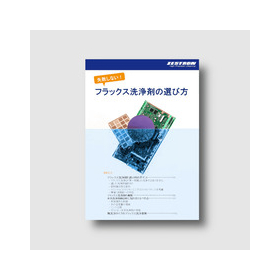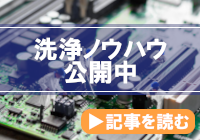news list
1~7 item / All 7 items
-

Added a page on the removal of "sintering agent residue + tackifier" composite organic matter [joint research with Mr. McDermid].
In recent years, the advancement of electronic devices has led to a demand for advanced bonding technologies that can withstand high temperatures, large currents, and high voltages. In particular, in power devices, there are increasing cases where conventional solder types do not provide sufficient performance. While high Pb solder and Au/Sn solder can be applied, the use of "sintered bonding" is expanding due to considerations such as environmental regulations and costs, as it can form a high-density bonding layer. This article will examine effective cleaning methods utilizing spray cleaning and ultrasonic cleaning, and introduce the features and application examples of the cleaning agents VIGON PE 305N and VIGON PE 216A for power electronics.
-

A page has been added for the joint research titled "Cleaning Issues of Water-Soluble Flux: Insulation Performance and Residue Analysis."
In current electronics assembly in Japan, rosin-based flux is predominantly used for soldering. However, due to the promotion of the SDGs and the growing interest in reducing environmental impact, there is an active evaluation of water-soluble flux, which is expected to reduce VOC emissions and cleaning burdens. This time, we will present an investigation into the actual cleaning conditions of water-soluble flux, which is recognized as easier to clean than rosin-based flux.
-

A page titled "Verification of Cleanability of Long Edge Resistance" has been added.
Long-side resistors refer to a type of chip resistor (resistor) on a substrate where the electrodes are arranged along the long side of the component. In recent years, there has been an increase in cases where they are used for the purpose of enhancing functionality and ensuring long-term stability. In this instance, we created a test board using general-purpose rectangular resistors (2012) and long-side resistors (1220), and conducted substrate cleaning using a cleaning agent primarily composed of water (manufactured by Zestron / VIGON PE 304N) and a general-purpose solvent-based cleaning agent primarily composed of organic alkali. For this verification, we received cooperation from Japan Superior Co., a solder manufacturer, and conducted a detailed analysis comparing the cleanliness of both types of resistors.
-

We have added a page on 'Free Download: SDGs in Electronic Device Cleaners'.
We have added a page titled "【Free Download】Cleaning Agents for Electronic Devices and SDGs." This document explains what requirements electronic devices have for achieving the SDGs and how cleaning of electronic devices should be approached from the perspective of the SDGs. It is recommended for those who want to achieve "cleaning that balances low-risk performance and cleaning performance" or who want to know about the cleaning technologies required for electronic devices. The content includes information on "Cleaning of Electronic Devices and SDGs" and "Reducing Risks Required for Cleaning Agents for Electronic Devices," so please take a moment to read it.
-

I have added a page explaining what water-soluble flux is, including its residues and analysis methods.
Water-soluble flux is a flux based on water, using water-soluble polymers such as polyoxyethylene alkyl ether. Currently, in Japan, rosin-based flux is the mainstream for soldering in electronics assembly, but due to the growing environmental awareness such as the SDGs, there is a movement to explore the transition to water-soluble flux, which is expected to have a VOC reduction effect. This document explains the role and applications of water-soluble flux, as well as residues, analysis methods, and cleaning methods.
-

Added a page on 'Case Study: Flux Cleaning Issues Due to High-Density Component Mounting.'
We would like to introduce a case study on the investigation of factors leading to cleaning defects in flux cleaning troubles caused by the high density of component mounting. With the increase in component mounting density, a change in the solder paste used was made, but there have been reports of defects believed to be caused by cleaning issues. Based on the information gathered, we inferred the current situation. We conducted an analysis and evaluation of the hypothesis, and based on the results, we proposed both temporary and permanent measures tailored to the customer's circumstances.
-

[Free Giveaway] How to Choose a Flux Cleaning Agent Without Making Mistakes!
This document explains how to choose flux cleaning agents. It provides specific examples of key points to consider when selecting flux cleaning agents and highlights the aspects to focus on. It also includes important considerations for water-based cleaning agents, such as controlling evaporation loss and variations in water content, as well as examples of non-cleaning type flux cleaning cases. We encourage you to read it. [Contents (partial)] ■ Key points for selecting flux cleaning agents ■ Types of flux cleaning agents ■ Considerations when evaluating water-based cleaning agents ■ Examples of non-cleaning type flux cleaning cases
